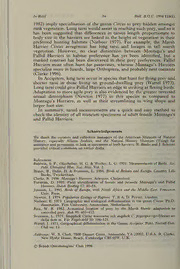Table Of ContentIn Brief 54 Bull. B.O.C. 1998 118(1)
1982) imply specialisation of the genus Circus to prey hidden amongst
rank vegetation. Long tarsi would assist in reaching such prey, and so it
has been suggested that differences in tarsus length proportionate to
body size in the harriers are linked to the height of vegetation in their
preferred hunting habitats (Nieboer 1977). For example, the Marsh
Harrier Circus aeruginosus has long tarsi and forages in tall marsh
vegetation. However, no clear distinction between Montagu's and
Pallid Harriers in habitat preference has yet been identified, but a
marked contrast has been discovered in their prey preferences. Pallid
Harriers most often hunt for passerines, whereas Montagu's Harriers
specialise more in lizards, large Orthoptera, and probably nest contents
(Clarke 1996).
In Accipiters, long tarsi occur in species that hunt for flying prey and
shorter tarsi in those living on ground-dwelling prey (Wattel 1973).
Long tarsi could give Pallid Harriers an edge in striking at fleeing birds.
Adaptation to more agile prey is also evidenced by the greater reversed
sexual dimorphism (Newton 1977) in this species as compared to
Montagu's Harriers, as well as their streamlining in wing shape and
larger foot size.
In summary, tarsal measurements are a quick and easy method to
check the identity of all museum specimens of adult female Montagu's
and Pallid Harriers.
Acknowledgements
We thank the curators and collection managers of the American Museum of Natural
History, especially Allison Andors, and the Natural History Museum (Tring) for
assistance and permissionto look at specimens ofboth harriers. R. Banks andJ. Schmitt
provided critical comments on earlier drafts.
References:
Baldwin, S. P., Oberholser, H. G. & Worley, L. G. 1931. Measurements of Birds. Sci.
Publ. ClevelandMus. Nat. Hist. Vol. 2.
Bruun, B., Delin, H. & Svensson, L. 1986. Birds ofBritain and Europe. Country Life
Books, Twickenham.
Clarke, R. 1996. Montagu'sHarriers. Arlequin, Chelmsford.
Forsman, D. 1995. Field identification of female and juvenile Montagu's and Pallid
Harriers. Dutch Birding 17: 41-54.
Jonsson, L. 1993. Birds ofEurope, with North Africa and the Middle East. Princeton
Univ. Press.
Newton, I. 1979. Population Ecology ofRaptors. T. & A. D. Poyser, London.
Nieboer, E. 1973. Geographic and ecological differentiation in the genus Circus. Ph.D.
dissertation. Free University, Amsterdam, Netherlands.
Rice, W. R. 1982. Acoustical location of prey by the Marsh Hawk: adaptation to
concealed prey. Auk 99: 403-413. —
Svensson, L. 1971. Stapphok Circus macrourus och angshok C.pygargus problemet att
skilja dem at. VdrFdgelvdrld 30: 106-121.
Wattel, J. 1973. Geographical differentiation in the Genus Accipiter. Publ. Nuttall Orn.
Club no. 13.
Addresses: W. S. Clark, 7800 Dassett Court, Annandale, VA 22003, U.S.A. R. Clarke,
New Hythe House, Reach, Cambridge CB5 OJW, U.K.
©
British Ornithologists' Club 1998
In Brief 55 5z///. 5.0.C. 1998 118(1)
Franklin's Gull Larus pipixcan at South
Georgia
by Keith Reid
Received24April 1997
On 20 January 1997 at 18.45 (local time) an unusual gull was seen flying
around Freshwater Bay, Bird Island (54°0rS, 38°03'W). When first
noticed the bird was flying over the beach, after which it landed briefly
onthe shorebeforeflyingoflFtothesoutheastandoutofsight. Theinitial
impression was of a small buoyant gull, compared to the resident Kelp
Gull L. domiuicamis, recalling Black-headed Gull L. ridibundus, with
noticeable long dark wings and a distinct dark marking on the head.
It was watched for approximately 5 minutes in good light through
7 X 42 binocu—lars at a range down to 20 m and the following description
taken. Head forehead, lores, chin and throat white; crown, nape
and ear-coverts dark, forming half hood extending to just in front
of eye. Eye dark with distinct pale upper and lower eye crescents.
Bill dark a—nd approximately equal in length to the loral distance.
Upperparts mantle and wing coverts dark grey, outer primaries
darker and lacking pale mirrors. Inner primaries and secondaries with
pale tips forming whitish trailing edge contrasting with dark secondary
bar and outer pri—maries. Tail white with distinct black sub-terminal
band. Underparts white.
In examining the possible species involved it is apparent that this
bird belonged to one of the group of small gulls which have dark
head markings in adult plumage. Withi—n this group three species
which regularly occur in South America Brown-hooded Gull Lams
macidipenuis,—Andean Gull L. serranus and Grey-headed Gull L.
cirrocephalus can all be ruled out as they have much paler grey mantle
and wing-coverts which form a very characteristic wing pattern
(Harrison 1983), different from the bird in question. This leaves
Laughing Gull L. atricUla and Franklin's Gull L. pipixcan, both of
which have amuch darker greybase colour across the wings and mantle.
Although the Laughing Gull shows a distinct dark subterminal tail
band in first winter plumage it has generally grey, not white, under-
parts (Grant 1982). In addition the Laughing Gull's bill is longer than
the loral length, often appearing "heavy and drooping" (Grant 1982).
Franklin's Gull has a distinctive dark halfhood withwhite eye-crescents
in aU plumages and first winter birds show a distinct dark subterminal
tail band (Grant 1982). From this combination of plumage and struc-
tural characters the bird was identified as a first winter Franklin's Gull.
Other than Kelp Gull, which is a common resident. Dolphin Gull L.
scoresbii is the only other gull species confirmed on the South Georgia
list (Prince & Croxall 1996). A single record ofBrown-hooded Gull was
considered unacceptable by Bourne (1988) as the description published
(Delany et al. 1988) could apply to a second winter Franklin's Gull.
Although Brown-hooded Gulls breed in southern South America,

